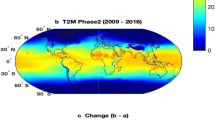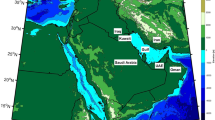Abstract
The customary representation of climate using sample moments is generally biased due to the noticeably nonstationary behaviour of many climate series. In this study, we introduce a moment-free climate representation based on a statistical model fitted to a long-term daily air temperature anomaly series. This model allows us to separate the climate and weather scale variability in the series. As a result, the climate scale can be characterized using the mean annual cycle of series and local air temperature tolerance, where the latter is computed using the fitted model. The representation of weather scale variability is specified using the frequency and the range of outliers based on the tolerance. The scheme is illustrated using five long-term air temperature records observed by different European meteorological stations.








Similar content being viewed by others
Notes
The term scaling is often used to denote a power law relationship D(x)=A x 2H between the function D(x) and its argument x, where A and 0<H<1 are constants (e.g., Yaglom 1986).
References
Box GEP, Jenkins GM, Reinsel GC (1994) Time series analysis. Forecasting and control, 3rd edn. Prentice Hall, Englewood Cliffs
Bryson RA (1997) The paradigm of climatology: an essay. Bull Amer Meteor Soc 78:449–455
Huang J, van den Dool HM, Barnston AG (1996) Long-lead seasonal temperature prediction using optimal climate normals. J Climate 9:809–817
Kärner O (2005) Some examples on negative feedback in the Earth climate system. Cent Eur J Phys 3:190–208
Kärner O (2007) Temporal variability in local air temperature series shows negative feedback. Energy Environ 18:1059–1072
Kärner O (2009) ARIMA representation for daily solar irradiance and surface air temperature time series. J Atmos Solar Terr Phys 71:841–847
Kärner O, de Freitas C (2011) Modelling long-term variability in daily air temperature time series for Southern Hemisphere stations. Environ Model Assess 17:221–229
Kärner O, de Freitas C (2013) Detecting climate variability signals in long air temperature records. Int J Climatology. doi:10.1002/joc.3797
Klein Tank AMG, et al. (2002) Daily dataset of 20th-century surface air temperature and precipitation series for the European Climate Assessment. Int J Climatology 22:1441–1453
Ladoy Ph, Lovejoy S, Schertzer D (1991) Extreme variability of climatological data: scaling and intermittency. In: Schertzer D, Lovejoy J (eds) Non-linear variability in geophysics. Kluwer, Dordrecht, pp 241–250
Livezey RE, Vinnikov KY, Timofeyeva MM, Tinker R, van den Dool HM (2007) Estimation and extrapolation of climate normals and climatic trends. J Appl Met Climatol 46:1759–1776
Lovejoy S, Schertzer D (1986) Scale invariance in climatological temperatures and the local spectral plateau. Ann Geophys 4B:401–410
Milly PCD, Betancourt J, Falkenmark M, Hinch RM, Kundzewicz ZW, Lettenmaier DP, Stouffer RJ (2008) Stationarity is dead: Whither water management? Science 319:573–574
North GR, Cahalan RF (1981) Predictability in a solvable stochastic climate model. J Atmos Sci 38:504–513
Pelletier JD (1997) Analysis and modeling the natural variability of climate. J Climate 10:1331–1342
Post P, Kärner O (2013) Time series analysis: a new methodology for comparing the temporal variability of air temperature. J Climatology 2013. doi:10.1155/2013/313917. Article ID 313917
Talkner P, Weber RO (2000) Power spectrum and detrended fluctuation analysis: application to daily temperature. Phys Rev Ser E 62:150–160
Wilks DS (2013) Projecting normals in a nonstationary climate. J Appl Met Climatol 52:289–302
World Meteorological Organization (1983) Guide to climatological practices. WMO-No. 100. Geneva
Yaglom AM (1986) Correlation theory of stationary and related random functions, vol I. Springer, New York
Acknowledgments
The study was partially supported by Estonian Ministry of Education and Research (IUT20-11 and ETF9134) and by the EU Regional Development Foundation, Environmental Conservation and Environmental Technology R & D Program Project No. 3.2.0801.12-0044.
Author information
Authors and Affiliations
Corresponding author
Rights and permissions
About this article
Cite this article
Kärner, O., Post, P. Local air temperature tolerance: a sensible basis for estimating climate variability. Theor Appl Climatol 126, 575–583 (2016). https://doi.org/10.1007/s00704-015-1594-8
Received:
Accepted:
Published:
Issue Date:
DOI: https://doi.org/10.1007/s00704-015-1594-8




